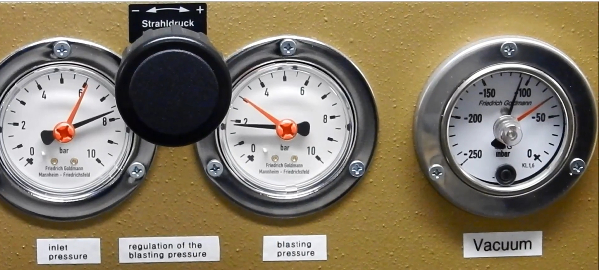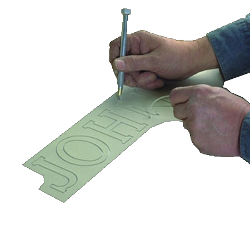Considerations
The basic question to ask yourself is “What exactly do I want to do and how am I going to do it?” Some of the things you will need to consider are …
The material and finish – virtually all tapes will stick well to polished granite but unpolished stone and stone with an open grain such as sandstone will require a high tack tape if stencil filler is to be avoided. Textured and curved surfaces will require the use of a tape that is soft and can be moulded to the shape of the surface.
The depth of blast required and the blasting pressure used – rubber tapes have more blast resistance than PVC based tapes and both will outperform paper tapes.
The detail required – where there is very fine detail and therefore little surface area contact with the stone a thin tape is less likely to lift than a thick tape. You will be able to cut finer detail in a rigid PVC tape than you will in a soft rubber tape which stretches.
The type of backing liner – important if you are not cutting directly on the stone. Myler or plastic backings resist the knife better than paper backings. Some paper backings delaminate if scored making them a nightmare to remove. Backings have different release properties. Whilst it is generally preferable to have an easy-release liner if it is too easy-release when used on a pinch roller plotter it can lead to disastrous results – the liner separates from the tape and the tape runs off track.
The method of cutting – is the stencil to be cut by hand or on a plotter?
If cutting by han d the tape needs to be easy to cut. This normally eliminates thick PVC tapes from the equation, leaving the choice to be between thin PVC, paper and rubber. Some paper tapes can be put through a photocopier, useful for transferring pre-drawn designs to the stencil.
d the tape needs to be easy to cut. This normally eliminates thick PVC tapes from the equation, leaving the choice to be between thin PVC, paper and rubber. Some paper tapes can be put through a photocopier, useful for transferring pre-drawn designs to the stencil. 

If cutting on a plotter, what type is it – flat bed, friction feed or sprocket feed? A flat bed plotter will cut any type of tape. If it is friction feed, currently the most popular type of plotter, the tape should be rigid enough to resist the compression forces put on it by the pinch rollers – if it is too soft the tape will not track properly through the plotter. If you are using a sprocket feed plotter, what type of hole configuration does it have? Whilst the industry standard sprocket configuration is ½” some manufacturers have introduced their own variations in the hope of restricting users to their products.
At the end of the day the main decision for many masons will be whether to use a rubber based tape or one of the newer PVC based tapes.
| Return to History... | Continue to Our Preferences... |

